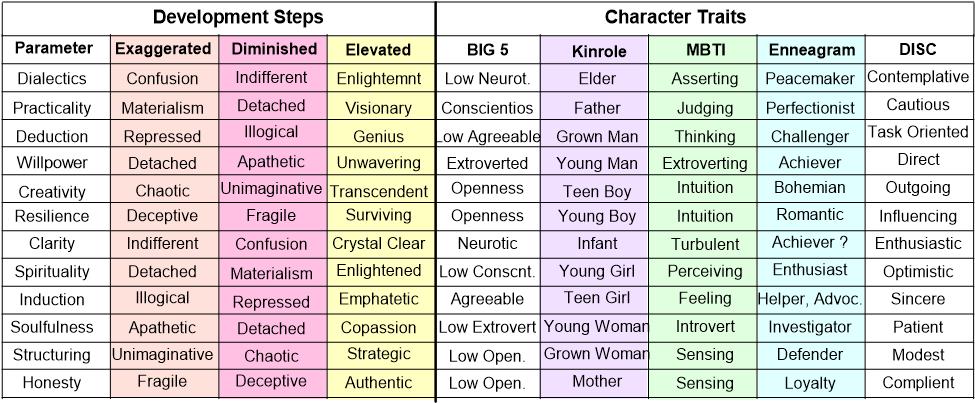Envision a tool that uncovers your inner strengths and weaknesses based on what you say or write. Wellcome to the “dialectical wheels” that evolve from dialectics:

The first wheel assumes opposition between the positive sides of any segment and the negative sides of its diagonal counterpart (i.e., T+ = A(A-), T- = A(A+), and so forth). The second is its “inverted” version that is useful for coordinate definition. The 3rd represents a practical application example. The dashed-dotted arrows exemplify transformation of one energy into another as described in the text beow.
Such wheels emerge from a simple concept map (as described in the Dialectics as a Gateway), and then adding intermediate steps to match the Atlas of Characters (that unites all the major personality models in a single scheme). So we obtain 12 coordinates that match all the major personality traits, and that are arranged in a circular order, where all coordinates naturally transform to each other in a clockwise direction. For instance, Dialexity (the ability to unite opposing views) naturally transforms to Practcality, then Reasoning, and so on. Every pair of diagonal oppositions makes a self-regulating entity: you can’t be high on any coordinate, while being low on its diagonal opposition, as they make semantic oppositions. For instance, you can’t be Authentic (top position in Honesty) and Deceptive (bottom in Resilience). However, small distortions are still possible, and this is why we occasionaly encounter problems and become unhappy. Suggesting the ways how to make this wheel symmetric and our lives more happy is the major goal of our method.
Example
Consider a dilemma of a wife after the maternity leave: stay home or go to work? This description is enough for generating her profile – see the red contour in the center of the 3rd wheel above (based on GPT’s evaluation). Blue contour denotes the ‘optimum mindset’ (also by GPT), suggesting the need for the higher Willpower, Deductive Reasoning, and Clarity of Priorities. But how to achieve this in reality?
The answer comes from the red contour by itself (3rd wheel, case C). The strongest side (Honesty at 0.5) must be converted to the weakest (Clarity at 0.2), through a chain of transformations marked by a blue path in the table below.

Red pattern indicates the traits possessed by the acting character, blue and green – required for balancing her life
The green path shows the counter-clockwise transformations that may apply for extroverts. No step can be skipped, as the true solution lays in the symmetry of entire profile. The harmonious growth requires concerted effort in all segments.
Non-Evident Relations
Since dialectic wheels are matched with character traits, all energies can be interpreted in multiple ways. For instance, Honesty represents the “Motherly energy” – loyalty and sensing, while Clarity represents the “infant energy” – purity and inspiration. This can be seen from the 3rd wheel (case C) and this s why Honesty doesn’t automatically means Clarity, and Clarity doesn’t automatically means Honesty. The following table summarizes such relations in a clearer way:

It aids in discerning between seemingly similar phenomena that are, in reality, distinct. For instance, take Dialectics and Spirituality. One is the capacity to embrace conflicting views, the other – the ability to perceive situations holistically. Both lead to enlightenment when developed, indifference if lacking, and detachment when excessive. However, Dialectics is linked to eldership (Kinrole), low neuroticism (Big 5), assertiveness (MBTI), peacemaking (Enneagram), and contemplation (DISC). Spirituality, conversely, correlates more with vivaciousness (Kinrole), low conscientiousness (Big 5), holistic perception (MBTI), enthusiasm (Enneagram), and optimism (DISC). Moreover, Dialectics arises from Honesty (moving clockwise), evolves into Practicality, and is tempered by Clarity of Priorities. Spirituality, on the other hand, springs from Clarity, progresses to Feelings and Induction, and is moderated by Practicality. Such nuanced distinctions could be perplexing without the aforementioned wheel(s) and table(s).
Other Uses
These coordinates can also be used for mapping any mindsets, including all real and fictious characters. This can help us to (1) quickly find the closest mindsets that can motivate us for change, and (2) match people based on mutual complementarities.
Another possibility is to assign these or other similar coordinates to various situations rather than people, in which case we could use the case-based reasoning and analogical thinking.
The third direction is clarifying our true priorities and purifying inner vaues, which in turn can be represented as various “value graphs” (see Dialectics as a Gateway). A map of our inner transformations that helps solving many tasks.
See Also:

